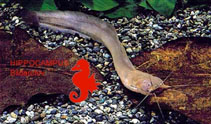| Family: |
Clariidae (Airbreathing catfishes) |
| Max. size: |
29.7 cm TL (male/unsexed) |
| Environment: |
demersal; freshwater |
| Distribution: |
Africa: lower reaches and the delta of the Niger (Nigeria) and the Cross basin (Nigeria and Cameroon)(Ref. 57129, 81644). Also reported from the rivers Ouémé (Benin) (Ref. 57129, 81644) and Osse (Nigeria)(Ref. 57129). |
| Diagnosis: |
Dorsal spines (total): -0; Dorsal soft rays (total): 96-109; Anal spines: -0; Anal soft rays: 83-94. Diagnosis: dorsal and anal fins always confluent with caudal fin (Ref. 57129, 81644). Body very elongate, maximum body depth 14-15% standard length (Ref. 57129), abdominal depth 4.5-8% SL (mean 6) (Ref. 81644). Head very short, 12.5-14.3% standard length; lateral cephalic bones separated from each other by a distinct gap (Ref. 57129). Distance between supraoccipital process and dorsal fin short, 5-14% SL; pectoral fins present, 30-56% skull length, supported by a short spine (about half of fin length); pelvic fins always present and short; skull short, 11-18% SL (mean 13), with a very narrow roof, 9-23% (mean 14) head length, partially covered by jaw muscles; these muscles almost completely exposed dorsally and laterally and frequently bulging (especially in larger specimens); supraoccipital process short and narrow, 10-20% (mean 16) head length; eyes very small (4-9%), bordered by small infraorbital bones (hard to observe externally); barbels long, maxillary longest (86-155% skull
length); maxillary barbel connected at base to large skin folds that border mouth opening; when mouth is closed, these skin flaps are folded and conspicuous in dorsal view; internal mandibular barbel shortest, 58-99% (mean 76) head length (Ref. 81644).
Coloration: in life: uniformly light brown (Ref. 81644). Preserved specimens: brownish-black on back and sides, light brown on belly (Ref. 57129). Ventral prepelvic region slightly paler than rest of body (Ref. 81644). |
| Biology: |
Prefers small streams and ditches with leaf litter. Also found in swamp regions. Diet probably consists of insect larvae, worms and similar smaller organisms. Fishes are not eaten (Ref. 78218).
|
| IUCN Red List Status: |
Least Concern (LC); Date assessed: 29 April 2019 Ref. (130435)
|
| Threat to humans: |
harmless |
Source and more info: www.fishbase.org. For personal, classroom, and other internal use only. Not for publication.

